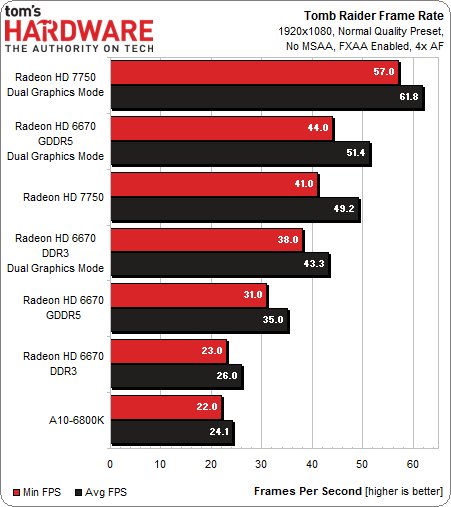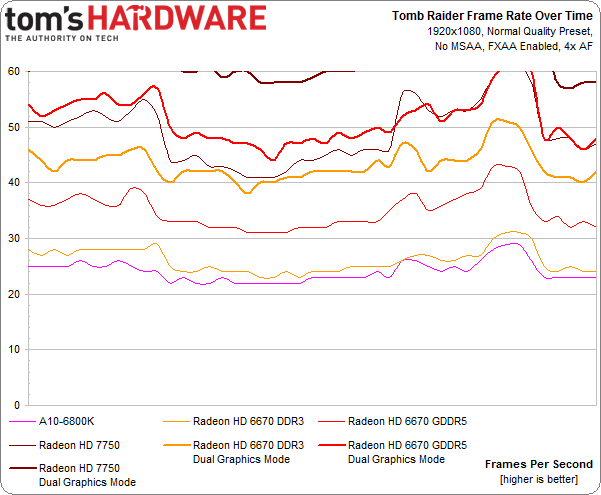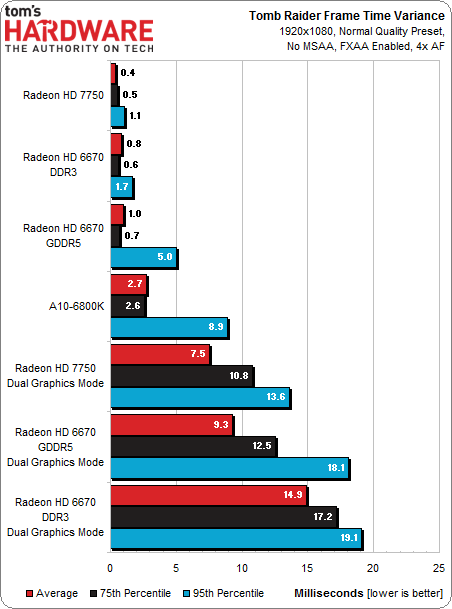AMD Dual Graphics Analysis: Better Benchmarks; Same Experience?
AMD's Dual Graphics technology gives APU owners the ability to add a discrete GPU to their platforms for better performance. We take a close look at the results, both in terms of frames-per-second and experiential smoothness, thanks to captured video.
Results: Tomb Raider
We begin our analysis with Tomb Raider, which is probably a best-case scenario for Dual Graphics since the title is sponsored by AMD. It also happens to be a lot of fun.
At least on paper, these benchmark results tell us that Dual Graphics has a pretty profound impact on performance, above and beyond what an APU on its own or an entry-level discrete GPU manages. As AMD suggests, its Radeon HD 6670 delivers the best price/performance ratio paired up to the A10-6800K APU, offering a 100% speed-up compared to the discrete card on its own.
The boost we measure from the GDDR5-equipped cards is less impressive. But despite mixing the VLIW5 and GCN architectures, there's still a clear improvement.
Plotting frame rate over time doesn't tell us anything different, though we see that the Dual Graphics setups deliver notably-higher frame rates than an APU or discrete GPU operating alone.
Now we take frame time variance into account. You can see that Dual Graphics introduces a significant amount of latency between subsequent frames. This latency can be responsible for dropped and runt frames, which counteract the benefit of a higher frame rate.
In the video below, you get a side-by-side comparison of the A10-6800K APU (24.1 FPS average), the A10-6800K APU with a Radeon HD 6670 DDR3 card in Dual Graphics mode (43.3 FPS average), and a Radeon HD 7750 on its own (49.2 FPS average).
The half-speed video gives us dramatic demonstration of what Fraps doesn't tell us: the Dual Graphics configuration is as choppy as the A10-6800K on its own, despite a near-doubling of average frame rate. Meanwhile, the Radeon HD 7750 is perfectly smooth. This effect isn't as severe at full-speed, but it's still noticeable.
Get Tom's Hardware's best news and in-depth reviews, straight to your inbox.
In this first title we're testing, it's quite obvious that there is a discrepancy between what you actually experience and what a benchmarking utility like Fraps suggests you should be seeing. The increase in frame time variance supports our hypothesis. Dual Graphics may increase the number of frames per second being rendered, but because they're predominantly dropped and runt frames, you're not actually seeing them during gameplay.
Current page: Results: Tomb Raider
Prev Page Video Demos, Test System And Benchmark Setup Next Page Results: The Elder Scrolls V: SkyrimDon Woligroski was a former senior hardware editor for Tom's Hardware. He has covered a wide range of PC hardware topics, including CPUs, GPUs, system building, and emerging technologies.
-
beta212 Hmm, IDK, I feel like there is definitely a performance boost in certain games that are just bordering on playability. That said, if you want really good graphics, why not buy the Athlon with disabled GPU cores? Same goes for the intel P series. Just add a discrete card.Reply -
17seconds "That's just not right."Reply
If I had just paid good money for a new graphics card for Dual Graphics, I'd be feeling pretty well cheated out of my money right now. -
joytech22 The drivers tested in this analysis are a tiny bit too old, just before the Crossfire Frame Pacing fix was released.Reply
Could we see this performed again with Catalyst 13.8?
-
cleeve Reply11356019 said:The drivers tested in this analysis are a tiny bit too old, just before the Crossfire Frame Pacing fix was released.
Could we see this performed again with Catalyst 13.8?
See page 2:
"You'll notice that we're using the Catalyst 13.6 Beta 2 driver instead of Catalyst 13.8 Beta, which adds a frame pacing feature for smoother, more consistent output. AMD tells us that the new driver does not affect Dual Graphics configurations. It only works with multiple discrete GPUs. Rest assured that the configuration we're presenting is as up to date as possible."
-
Calculatron Despite the bad news, I think this article was just what a lot of people needed. It helps clears up a lot of confusion and hearsay about AMD Dual Graphics options, like the being able to enable the Radeon HD 7750, or if GDDR5 makes any difference or not. More importantly, it shows how important software optimization is for product performance, and hopefully AMD strives to eliminate similar issues in the future.Reply
As this issue unfolds, I hope there are as informative follow-ups to accompany them. Good job! -
rpgplayer Well, now I see that my Llano box I built for a media center 2 years ago will be completely rebuilt rather than getting an add in card. If AMD's next gen APU will use the FM2+ boards as well I may go that route. If not, I'll probably wind up dumping AMD all together and go with an Intel rig.Reply -
If only AMD spent more of their time and their resources on software optimization rather than on those competition-bashing ads. Seeing some silly ads or reading about some flip/flopping (I now get paid by a different overlord) salesman, bashing Intel or nVidia products, does not instill the confidence in buying AMD products, specifically their APUs and (professional) GPUs. I really do want to buy your stuff AMD; less marketing more software development...pleeease.Reply



